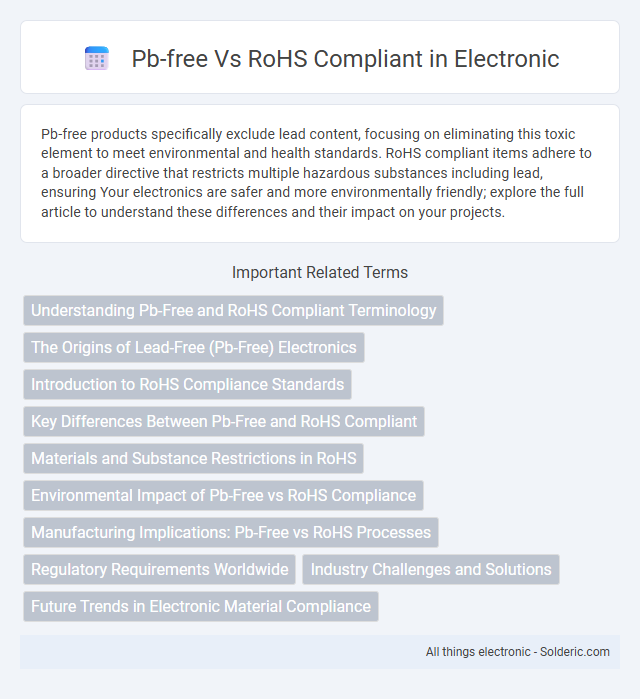Pb-free products specifically exclude lead content, focusing on eliminating this toxic element to meet environmental and health standards. RoHS compliant items adhere to a broader directive that restricts multiple hazardous substances including lead, ensuring Your electronics are safer and more environmentally friendly; explore the full article to understand these differences and their impact on your projects.
Comparison Table
| Feature | Pb-Free | RoHS Compliant |
|---|---|---|
| Definition | Products manufactured without lead (Pb) | Products meeting EU Restriction of Hazardous Substances Directive limits |
| Lead Content | 0% lead content | Lead limited to 0.1% by weight in homogenous materials |
| Scope | Focuses solely on lead elimination | Restricts multiple hazardous substances including Pb, Hg, Cd, Cr6+, PBB, PBDE |
| Regulatory Requirement | Industry-driven or customer-specific | Legally mandated in the European Union and other regions |
| Purpose | Reduce lead toxicity in manufacturing and usage | Protect human health and environment from hazardous substances |
| Application | Used in soldering, electronics, and coatings | Applies to electrical/electronic equipment sold within EU |
Understanding Pb-Free and RoHS Compliant Terminology
Pb-free refers specifically to electronic components and solder materials that do not contain lead, reducing environmental and health hazards associated with lead exposure. RoHS compliant indicates adherence to the Restriction of Hazardous Substances Directive, which limits the use of multiple hazardous materials, including lead, mercury, cadmium, hexavalent chromium, PBB, and PBDE, in electrical and electronic equipment. Understanding these terms is essential for manufacturers and consumers prioritizing eco-friendly production and regulatory compliance in electronics.
The Origins of Lead-Free (Pb-Free) Electronics
The origins of lead-free (Pb-free) electronics stem from growing environmental and health concerns associated with lead use in traditional soldering processes, especially in electronic assemblies. Emerging regulations like the Restriction of Hazardous Substances (RoHS) Directive enforced by the European Union in 2006 mandated a significant reduction or elimination of lead and other hazardous materials in electronic products. This regulatory shift accelerated the development and adoption of Pb-free solder alloys, such as SAC (tin-silver-copper), to ensure compliance while maintaining product reliability and performance.
Introduction to RoHS Compliance Standards
RoHS compliance standards restrict the use of hazardous substances such as lead, mercury, and cadmium in electronic and electrical equipment to protect human health and the environment. Pb-free products specifically exclude lead to meet these environmental regulations, ensuring safer disposal and recycling processes. Understanding RoHS compliance is essential for your electronics manufacturing to align with global environmental directives and maintain market access.
Key Differences Between Pb-Free and RoHS Compliant
Pb-free refers specifically to materials and products that do not contain lead (Pb), aiming to eliminate lead due to its toxicity in manufacturing and consumer use. RoHS compliant encompasses a broader regulatory standard restricting the use of multiple hazardous substances, including lead, mercury, cadmium, hexavalent chromium, PBB, and PBDE, in electrical and electronic equipment within the European Union. The key difference lies in Pb-free targeting only lead elimination, while RoHS compliance ensures adherence to comprehensive hazardous substance limits to improve environmental and human health safety.
Materials and Substance Restrictions in RoHS
RoHS compliance strictly limits hazardous substances such as lead, mercury, cadmium, hexavalent chromium, and specific flame retardants (PBB and PBDE) in electronic products, ensuring restrictions go beyond simply being lead-free. Materials used in RoHS-compliant products must meet maximum concentration values, typically 0.1% or 0.01% by weight depending on the substance, to minimize toxic environmental impact. Pb-free products only exclude lead specifically, but RoHS compliance addresses a broader spectrum of toxic materials to enhance safety and sustainability in electronics manufacturing.
Environmental Impact of Pb-Free vs RoHS Compliance
Pb-free materials significantly reduce lead contamination, mitigating soil and water pollution compared to traditional leaded solder. RoHS compliance enforces strict limits on hazardous substances, including lead, cadmium, and mercury, promoting safer electronic waste disposal and recycling. Both Pb-free and RoHS standards contribute to minimizing toxic environmental impact through reduced heavy metal usage in electronic products.
Manufacturing Implications: Pb-Free vs RoHS Processes
Pb-free manufacturing requires the elimination of lead in solder alloys, demanding higher reflow temperatures and adjustment of equipment to handle thermal stress, potentially increasing production costs and affecting component reliability. RoHS compliant processes mandate adherence to strict limits on hazardous substances, including lead, mercury, and cadmium, necessitating comprehensive material screening and supplier verification to ensure regulatory compliance. Both processes impact production workflows, but RoHS compliance encompasses a broader scope of substance restrictions beyond just lead-free soldering requirements.
Regulatory Requirements Worldwide
Pb-free materials eliminate lead content to meet strict regulatory mandates aimed at reducing environmental and health hazards, while RoHS compliance ensures electronic products adhere to specific limits on hazardous substances across multiple jurisdictions. These regulations, enforced in regions such as the European Union, China, and Japan, require manufacturers to certify their products to prevent lead exposure, promoting safer recycling and disposal practices. You must verify that your products satisfy both Pb-free criteria and RoHS standards to access global markets and avoid penalties associated with non-compliance.
Industry Challenges and Solutions
Pb-free soldering addresses the toxicity concerns of lead but presents challenges such as higher melting temperatures and joint reliability issues in electronics manufacturing. RoHS compliance demands strict adherence to hazardous substance limits, driving the industry to innovate new materials and processes that maintain product performance while reducing environmental impact. Advanced alloy formulations and enhanced thermal profiling techniques provide effective solutions to balance Pb-free requirements with RoHS directives in mass production.
Future Trends in Electronic Material Compliance
Pb-free materials are becoming the industry standard in electronic manufacturing due to increasing global regulations and consumer demand for eco-friendly products. RoHS compliant components ensure that electronic devices contain restricted hazardous substances, promoting sustainability and reducing environmental impact. Future trends highlight stricter enforcement of RoHS standards and innovations in alternative materials to meet higher performance and environmental safety requirements.
Pb-free vs RoHS compliant Infographic

 solderic.com
solderic.com